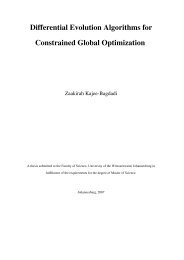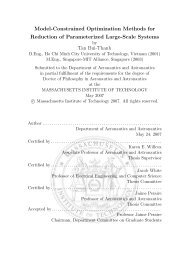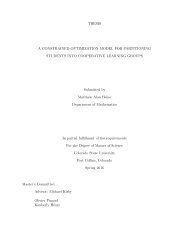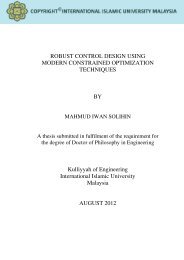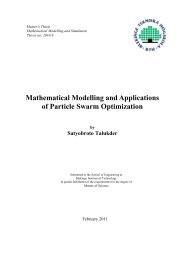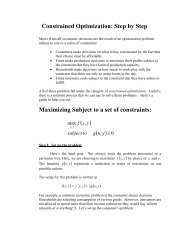Application of Genetic Algorithm in Multi-objective Optimization
Create successful ePaper yourself
Turn your PDF publications into a flip-book with our unique Google optimized e-Paper software.
Here, is the value <strong>of</strong> <strong>in</strong>dividual i and is the size <strong>of</strong> the population. Before this fitness<br />
assignment, the <strong>objective</strong> function goes through a l<strong>in</strong>ear transformation us<strong>in</strong>g the follow<strong>in</strong>g<br />
equation:<br />
<br />
Here, the sign <strong>of</strong> , the scal<strong>in</strong>g factor, depends on the optimization type, if it is maximization<br />
problem, will be positive, and vice versa. The comb<strong>in</strong>ation <strong>of</strong> this scal<strong>in</strong>g and fitness assignment<br />
ensures rapid convergence to the optimal results. Another approach to transform<strong>in</strong>g the <strong>objective</strong><br />
function is power law scal<strong>in</strong>g, mathematically:<br />
<br />
Here, k is the problem dependent variable and can be changed to control the range <strong>of</strong> fitness<br />
measures if required. Baker [27] suggested a rank based approach to prevent premature convergence,<br />
where <strong>in</strong>stead <strong>of</strong> us<strong>in</strong>g raw performance, the rank <strong>of</strong> <strong>in</strong>dividuals <strong>in</strong> the population is used to measure<br />
relative fitness.<br />
2.3.1.3. Selection:<br />
Selection is the determ<strong>in</strong>ation process <strong>of</strong> how many times a particular <strong>in</strong>dividual will participate <strong>in</strong><br />
reproduction. It comprises <strong>of</strong> two processes. In the first process, the raw fitness values are<br />
converted <strong>in</strong>to a real-valued expectation <strong>of</strong> an <strong>in</strong>dividual’s probability to be chosen for reproduction.<br />
The second process, also known as “sampl<strong>in</strong>g”, selects an <strong>in</strong>dividual probabilistically for<br />
reproduction based on its fitness relative to other <strong>in</strong>dividuals. The performance <strong>of</strong> the selection<br />
algorithm can be determ<strong>in</strong>ed by us<strong>in</strong>g three measures which are bias, spread, and efficiency. The<br />
absolute difference between the actual and expected probability <strong>of</strong> an <strong>in</strong>dividual for gett<strong>in</strong>g selected<br />
is def<strong>in</strong>ed as bias. Spread can be def<strong>in</strong>ed as the range <strong>of</strong> the possible number <strong>of</strong> times <strong>in</strong> which the<br />
32



